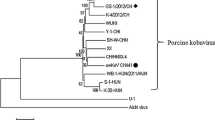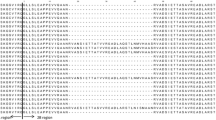Abstract
Kobuvirus is a new genus in the family Picornaviridae. Two species are currently known: Aichi virus (human kobuvirus) and Bovine kobuvirus (U-1). In this study, the complete nucleotide and amino acid sequences and genetic organization of porcine kobuvirus (Kobuvirus/swine/S-1-HUN/2007/Hungary, EU787450) were determined. The structure of the S-1-HUN genome, VPg–5′UTR–leader protein–structural proteins (VP0, VP3, VP1)–non-structural proteins (2A–2C, 3A–3D)–3′UTR–poly(A) tail, was found to be typical of picornavirus. The 8210-nucleotide (nt)-long RNA genome contains a large open reading frame (7467 nt) encoding a potential polyprotein precursor of 2488 amino acids (aa) that has 57/56% and 63/64% nt/aa identity with Aichi virus and U-1, respectively. The 5′UTR contains a hepacivirus/pestivirus-like internal ribosomal entry site (IRES type IV group-B-like) with conserved pseudoknot, II and IIIa–f domains. A tandem repeat (a 30-amino-acid-long motif) was detected in 2B. Thirty-nine (65%) of the 60 fecal samples from pigs under the age of 6 months at the tested farm were positive (the incidence was 90% under the age of 3 weeks). Porcine kobuvirus belongs to a potential new species—the third—in the genus Kobuvirus.





Similar content being viewed by others
References
Ambert-Balay K, Lorrot M, Bon F, Giraudon H, Kaplon J, Wolfer M, Lebon P, Gendrel D, Pothier P (2008) Prevalence and genetic diversity of Aichi virus strains in stool samples from community and hospitalized patients. J Clin Microbiol 46:1252–1258
Brill S, Li S, Lyman CW, Church DM, Wasmuth JJ, Weissbach CW, Bernards A, Snijders AJ (1996) The Ras GTPase-activating-protein-related human protein IQGAP2 harbors a potential actin binding domain and interacts with calmodulin and Rho family GTPases. Mol Cell Biol 16:4869–4878
Chen HH, Kong WP, Roos RP (1995) The leader peptide of Theiler’s murine encephalomyelitis virus is a zinc-binding protein. J Virol 69:8076–8078
de Jong A, de Mattia F, van Dommelen M, Lanke K, Melchers WJG, Willems HGM, van Kuppeveld FJM (2008) Functional analysis of picornavirus 2B proteins: effects on calcium homeostasis and intracellular protein trafficking. J Virol 82:3782–3790
Gorbalenya AE, Koonin EV, Lai MM (1991) Putative papain-related thiol proteases of positive-strand RNA viruses. Identification of rubi- and aphthovirus proteases and delineation of a novel conserved domain associated with proteases of rubi-, alpho- and coronaviruses. FEBS Lett 288:201–205
Hellen CUT, de Breyne S (2007) A distinct group of hepacivirus/pestivirus-like internal ribosomal entry sites in members of diverse Picornavirus genera: evidence for modular exchange of functional noncoding RNA elements by recombination. J Virol 81:5850–5863
Hughes PJ, Stanway G (2000) The 2A proteins of three diverse picornaviruses are related to each other and to the H-rev107 family of proteins involved in the control of cell proliferation. J Gen Virol 81:201–207
ICTV Online, Discussion Forum of the International Committee on Taxonomy of Viruses, ICTV 2008 Official Taxonomy. http://talk.ictvonline.org
Jiang X, Huang PW, Zhong WM, Farkas T, Cubitt DW, Matson DO (1999) Design and evaluation of a primer pair that detects both Norwalk- and Sapporo-like caliciviruses by RT-PCR. J Virol Methods 83:145–154
Kaku Y, Chard LS, Inoue T, Belsham GJ (2002) Unique characteristics of a picornavirus internal ribosome entry site from the porcine teschovirus-1 Talfan. J Virol 76:11721–11728
Kapoor A, Victoria J, Simmonds P, Wang C, Shafer RW, Nims R, Nielsen O, Delwart E (2008) A highly divergent picornavirus in a marine mammal. J Virol 82:311–320
Khamrin P, Maneekarn N, Peerakome S, Okitsu S, Mizuguchi M, Ushijama H (2008) Bovine kobuviruses from cattle with diarrhea. Emerg Infect Dis 6:985–986
Kumar S, Tamura K, Jakobsen IB, Nei M (2001) MEGA2: molecular evolutionary genetics analysis software. Bioinformatics 17:1244–1245
Nicholas KB, Nicholas HB Jr (1997) GeneDoc: a tool for editing and annotating multiple sequence alignments
Oh DY, Silva PA, Hauroeder B, Deidrich S, Cardoso DD, Schreier E (2006) Molecular characterization of the first Aichi viruses isolated in Europe and in South America. Arch Virol 151:1199–1206
Palmquist JM, Munir S, Taku A, Kapu V, Goyal SM (2002) Detection of porcine teschovirus and enterovirus type II by reverse transcription-polymerase chain reaction. J Vet Diagn Invest 14:476–480
Pham NT, Khamrin P, Nguyen TA, Kanti DS, Phan TG, Okitsu S, Ushijama H (2007) Isolation and molecular characterization of Aichi viruses from fecal specimens collected in Japan, Bangladesh, Thailand, and Vietnam. J Clin Microbiol 45:2287–2288
Racaniello VR (2007) Picornaviridae: the viruses and their replication. In: Knipe DM, Howley PM (eds) Fields virology, 5th edn. Lippincott Williams & Wilkins, Philadelphia, pp 795–838
Reuter G, Krisztalovics K, Vennema H, Koopmans M, Szűcs Gy (2005) Evidence of the etiological predominance of norovirus in gastroenteritis outbreaks—emerging new variant and recombinant noroviruses in Hungary. J Med Virol 76:598–607
Reuter G, Boldizsár Á, Kiss I, Pankovics P (2008) Candidate new species of Kobuvirus in porcine hosts. Emerg Infect Dis 12:1968–1970
Sasaki J, Kusuhara Y, Maeno Y, Kobayashi N, Yamashita T, Sakae K, Takeda N, Taniguchi K (2001) Construction of an infectious cDNA clone of Aichi virus (a new member of the family Picornaviridae) and mutational analysis of a new stem-loop structure at 5′ end of the genome. J Virol 75:8021–8030
Stanway G, Hovi T, Knowles N, Hyypia T (2002) Molecular and biological basis of picornavirus taxonomy. In: Semler BL, Wimmer E (eds) Molecular biology of picornaviruses. ASM, Washington DC, pp 17–24
Stanway G, Brown F, Christian P, Hovi T, Hyypiä T, King AMQ, Knowles NJ, Lemon SM, Minor PD, Pallansch MA, Palmenberg AC, Skern T (2005) Family Picornaviridae. In: Fauquet CM, Mayo MA, Maniloff J, Desselberger U, Ball LA (eds) Virus taxonomy. Eight Report of the International Committee on Taxonomy of Viruses. Elsevier/Academic Press, London, pp 757–778
Thompson JD, Gibson TJ, Plewniak F, Jeanmougin F, Higgins DG (1997) The ClustalX windows interface: flexible strategies for multiple sequence alignment aided by quality analysis tools. Nucleic Acids Res 25:4876–4882
Yamashita T, Kobayashi S, Sakae K, Nakata S, Chiba S, Ishihara Y, Isomura S (1991) Isolation of cytopathic small round viruses with BS-C-1 cells from patients with gastroenteritis. J Infect Dis 164:954–957
Yamashita T, Sakae K, Tsuzuki H, Suzuki Y, Ishikawa N, Takeda N, Miyamura T, Yamazaki S (1998) Complete nucleotide sequence and genetic organization of Aichi virus, a distinct member of Picornaviridae associated with acute gastro-enteritis in humans. J Virol 72:8408–8412
Yamashita T, Sugiyama M, Tsuzuki H, Sakae K, Suzuki Y, Miyazaki Y (2000) Application of a reverse transcription-PCR for identification and differentiation of Aichi virus, a new member of the picornavirus family associated with gastroenteritis in humans. J Clin Microbiol 38:2955–2961
Yamashita T, Ito M, Kabashima Y, Tsuzuki H, Fujiura A, Sakae K (2003) Isolation and characterization of a new species of kobuvirus associated with cattle. J Gen Virol 84:3069–3077
Zucker M (2003) Mfold web server for nucleic acid folding and hybridization prediction. Nucleic Acids Res 31:3406–3415
Acknowledgments
We thank Teruo Yamashita for kindly providing an Aichi virus prototype strain A846/88 in year 2001. We thank István Kiss and Sándor Kecskeméti for animal sampling. We thank Zsuzsanna Kocsis for English editing of the manuscript. This work was supported by grants from the Hungarian Scientific Research Fund (OTKA, F048433), and the project “Enteric Virus Emergence, New Tools” (EVENT, SP22-CT-2004-502571) funded by the European Union.
Author information
Authors and Affiliations
Corresponding author
Additional information
Nucleotide sequence data reported are available in the GenBank database under accession number EU787450.
Rights and permissions
About this article
Cite this article
Reuter, G., Boldizsár, Á. & Pankovics, P. Complete nucleotide and amino acid sequences and genetic organization of porcine kobuvirus, a member of a new species in the genus Kobuvirus, family Picornaviridae . Arch Virol 154, 101–108 (2009). https://doi.org/10.1007/s00705-008-0288-2
Received:
Accepted:
Published:
Issue Date:
DOI: https://doi.org/10.1007/s00705-008-0288-2




